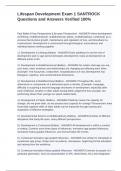Lifespan Development Exam 1 SANTROCK
Questions and Answers Verified 100%
Paul Baltes 8 Key Perspectives (Life-span Perspective) - ANSWER-Views development
as lifelong, multidimensional, multidirectional, plastic, multidisciplinary, contextual, as a
process that involves growth, maintenance and regulation of loss, and biocultural co-
constructivist. Development is constructed through biological, sociocultural, and
individual factors working together.
1.) Development is Lifelong (Baltes) - ANSWER-Early adulthood is not the end of
development and no age period dominates development, looks at development at
different points in life.
2.) Development is Multidimensional (Baltes) - ANSWER-No matter what age you are,
your body, mind, emotions and relationships are changing and affecting each other.
(Example: Ted Kaczynski, Unabomber, hospitalization at 6 mo) Development has
biological, cognitive, and socioemotional dimensions.
3.) Development is Multidirectional (Baltes) - ANSWER-Throughout life, some
dimensions or components of a dimension grow or decline. (Example: Language,
difficulty in acquiring a second language decreases in development, especially after
early childhood. Another is older adults having better judgement than younger, but
performing slower than younger on speed related task)
4.) Development is Plastic (Baltes) - ANSWER-Plasticity means the capacity for
change. (As we grow older, do we possess less capacity for change? Researchers have
found that cognitive skills of older adults can be improved through training and
acquisition of effective strategies)
5.) Developmental Science is Multidisciplinary (Baltes) - ANSWER-Number of different
disciplines that study life-span, many different perspectives.
6.) Development is Contextual (Baltes) - ANSWER-All development is within a context
or setting. Contexts exert three types of influences, normative age-graded influences,
normative history-graded influences, and nonnormative life events.
6.) Contextual normative age-graded influences - ANSWER-Are similar for individuals in
a particular age group, things such as puberty, menopause, beginning formal education
and retiring from the workforce.
6.) Contextual normative history-graded influences - ANSWER-Common to people of a
particular generation. Such as assassination of JFK, World Wars, 9/11 and integration
, of cell phones and computers into everyday life (cohort effects) Cohort is the year in
which you were born.
6.) Contextual nonnormative life events - ANSWER-Development at a slower rate, less
rapid decline. Are unusual occurrences that have a major impact on the lives of an
individual.
7.) Growth, Maintenance, and Regulation of Loss (Baltes) - ANSWER-Once you get to
an age where you're done growing, you worry about maintaining that growth and then
regulating it as you decline.
8.) Development Is a Co-construction of Biology, Culture, and the Individual - ANSWER-
Can create an unique developmental path through everyday decisions and have the
ability to change aspects, since we're the smartest.
Biological Processes - ANSWER-Changes in an individual's physical nature
Cognitive Processes - ANSWER-Changes in an individual's thought, intelligence, and
language.
Socioemotional Processes - ANSWER-Changes in an individual's interpersonal
relationships, emotions, and personality.
Psychoanalytic Theories (Freud) - ANSWER-Theories that describe development as
primarily unconscious and heavily colored by emotion. Behavior is merely a surface
characteristic, and the symbolic workings of the the mind have to be analyzed the
understand behavior. Early experiences with parents are emphasized.
Freud's Theory - ANSWER-He thought as children grow up, their focus of pleasure and
sexual impulses shifts from the mouth to the anus and to eventually, the genitals. As a
result we go through five stages of psychosexual development: oral, anal, phallic,
latency, and genital. Freud overemphasized sexual instincts; more influence should be
placed on cultural experiences as determinants of an individual's development.
Conscious thought plays a greater role than unconscious. Erik Erikson revised his idea.
Erikson's Psychosocial Theory - ANSWER-Includes eight stages of human
development. Each stage consists of a unique developmental task that confronts
individuals with a crisis that must be resolved.
1.) Trust vs Mistrust (Erikson) - ANSWER-Experienced in the first year of life,
development of trust during infancy sets stage for lifelong expectation that world will be
a good and pleasant place to live.
2.) Autonomy vs Shame and Doubt (Erikson) - ANSWER-Occurs in late infancy and
toddlerhood. After gaining trust in caregivers, infants begin to discover that their
behavior is their own, start to assert their sense of independence and autonomy, if
restrained or punished too much they are likely to develop a sense of shame and doubt.




